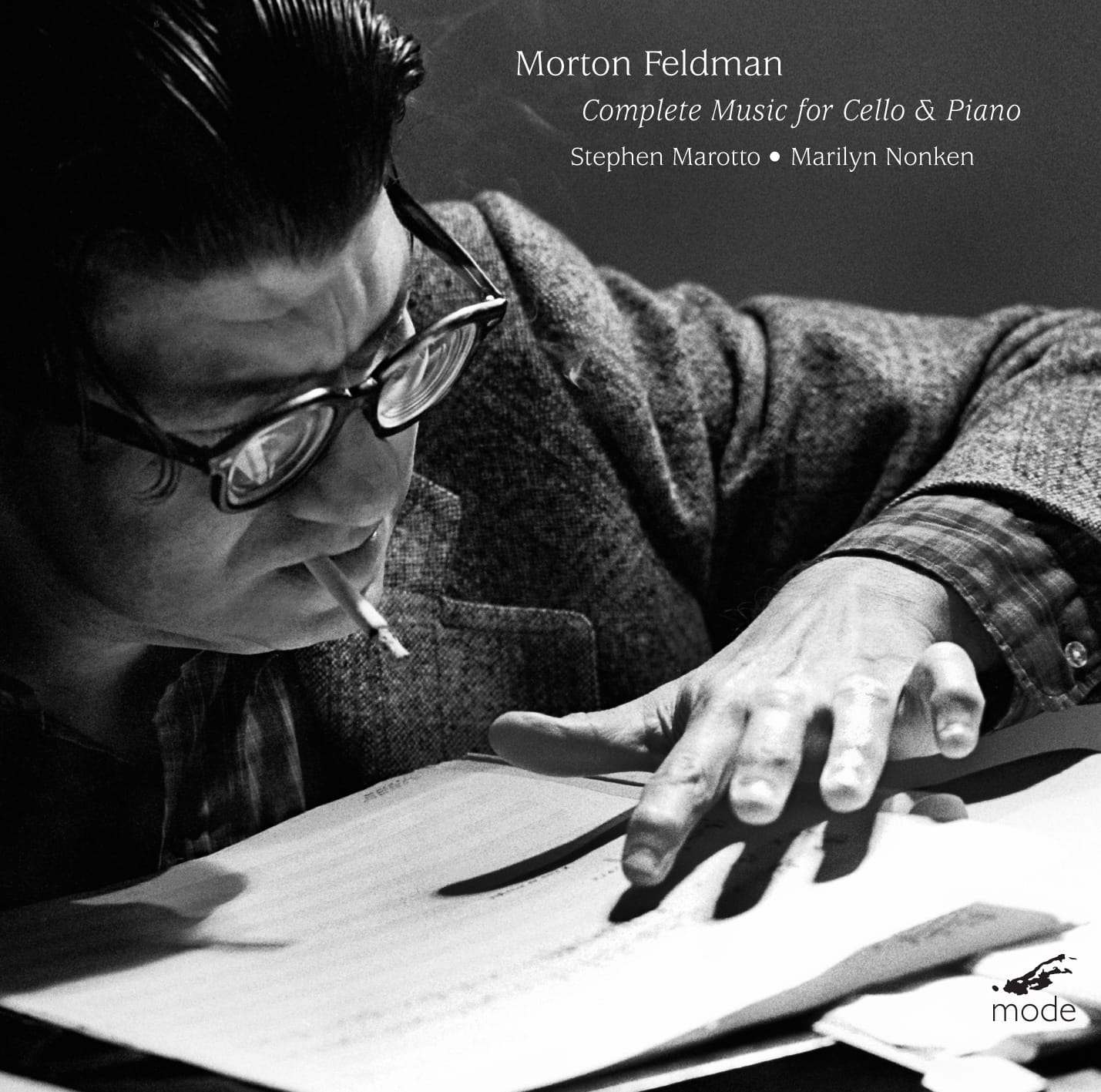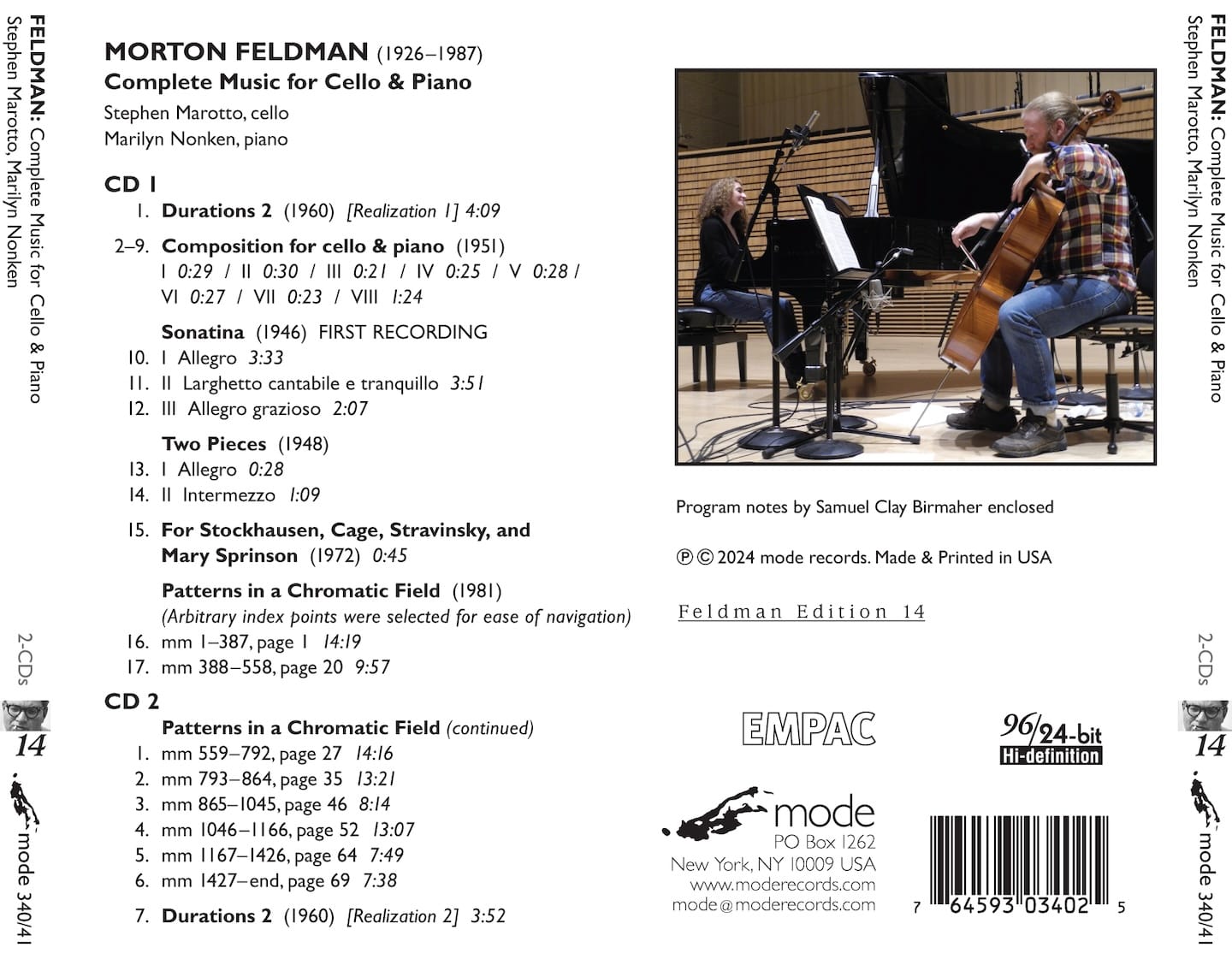MORTON FELDMAN (1926–1987)
Complete Music for Cello & Piano
Stephen Marotto, cello
Marilyn Nonken, piano
CD 1
1. Durations 2 (1960) [Realization 1] 4:09
2–9. Composition for cello & piano (1951)
I 0:29 / II 0:30 / III 0:21 / IV 0:25 / V 0:28 / VI 0:27 / VII 0:23 / VIII 1:24
Sonatina (1946) FIRST RECORDING
10. I Allegro 3:33
11. II Larghetto cantabile e tranquillo 3:51
12. III Allegro grazioso 2:07
Two Pieces (1948)
13. I Allegro 0:28
14. II Intermezzo 1:09
15. For Stockhausen, Cage, Stravinsky, and Mary Sprinson (1972) 0:45
Patterns in a Chromatic Field (1981)
(Arbitrary index points were selected for ease of navigation)
16. mm 1–387, page 1 14:19
17. mm 388–558, page 20 9:57
CD 2
Patterns in a Chromatic Field (continued)
1. mm 559–792, page 27 14:16
2. mm 793–864, page 35 13:21
3. mm 865–1045, page 46 8:14
4. mm 1046–1166, page 52 13:07
5. mm 1167–1426, page 64 7:49
6. mm 1427–end, page 69 7:38
7. Durations 2 (1960) [Realization 2] 3:52
This release brings together ALL of Morton Feldman’s compositions for cello and piano, including unpublished works and a first recording.
Together, these works tell the story of Feldman’s music. They span 35 years — over half his lifetime — from when he was searching for his voice as a student to when he was opening new doors in the last years of his life.
The album is bookended by two realizations the graphic score “Durations 2” (1960), giving an opportunity to hear what the flexibility of graphic notation can bring.
The “Sonatina” (1946) is earliest work here, and a first recording. Displaying the influence of Béla Bartók, Feldman wrote for the cello sound he loved without fully understanding the realities of playing the instrument. The resulting solo part is naively virtuosic and often even impossible to play. For this recording, Stephen Marotto keeps as close as possible to the written score, aiming to fulfill what Feldman heard in his mind’s ear.
By 1948, Feldman had been studying privately with the composer Stefan Wolpe for several years. The unpublished “Two Pieces,” of that year is a fluctuating music held together not by logic, but through its carefully poised gestures — what Wolpe called “shape.” While the emotional drama of this and other early works would soon disappear from Feldman’s music, it was above all the idea of “shape” that remained with him for the rest of his life.
In 1950, Feldman met John Cage, who shepherded him into the world of the New York avant-garde. The unpublished, compact, “Composition for cello and piano” (1951) is a sudden breakthrough, yet it already contains the DNA of his very last works in its minimal material and blurred memories of sounds.
“For Stockhausen, Cage, Stravinsky, and Mary Sprinson” (1972) is an ephemeral, unpublished piece, a shard of music broken off from the main body of work Feldman was producing at the time. It consists of just two musical moments separated by silence — the same chord expressed in two different ways.
At almost 1 hour 29 minutes, “Patterns in a Chromatic Field” (1981) is of Feldman’s late, long duration period of works and it perhaps the best known of the works recorded here.
Liner notes by Samuel Clay Birmaher.


